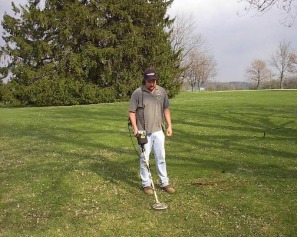Metal Detecting
A metal detector is simply an electronic device that detects the presence of metal, primarily through the transmission and reception of radio wave signals. Members use metal detectors to locate coins and relics lost over time. The number of lost coins far exceeds the total in circulation today.
Modern metal detectors are able to identify metal targets based on their composition and other characteristics. A typical modern metal detector will have a number or graph representing various commonly found objects such as a penny, pull tab or iron nail. Once a “good” signal has been located, the user then pinpoints the target. Once the target location has been narrowed down, it is retrieved with a small hand tool designed to do little, if any, damage to the land. Typically, a U-shaped cut is made three to four inches deep. The sod is then folded back, and a small electronic pinpointer (much like a mini-metal detector) helps to locate and retrieve the target. Once the item is retrieved, any loose soil is then returned to the hole and the sod is folded back into place. The sod is then stepped on to seat it back into place with little evidence of any disturbance to the area. The Dayton Diggers believes in "responsible" metal detecting. Responsible is defined by the Society of American Archaeology as the following:
|

